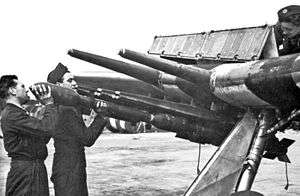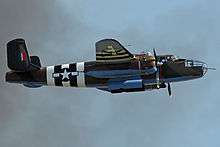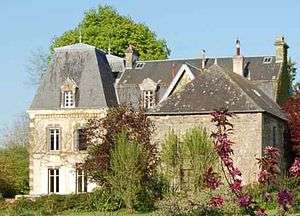RAF raid on La Caine (1944)
The RAF raid on La Caine (1944) was an attack in Normandy by the Second Tactical Air Force of the Royal Air Force (RAF) on 10 June 1944. The attack was made on the château at La Caine, about 12 mi (19 km) to the south-west of the city of Caen, north of Thury-Harcourt. The château had recently been occupied by Panzergruppe West, the command organisation for the German Panzer divisions in France and Belgium. Eighteen staff officers were killed in the attack and the commander, General der Panzertruppen Leo Geyr von Schweppenburg was wounded. A counter-offensive being prepared against the Allied beachhead by the Panzergruppe was postponed and then cancelled; command was transferred to the headquarters of the I SS Panzer Corps. Panzergruppe West was withdrawn to Paris and remained out of action until 28 June.
Background
Panzergruppe West
Generalfeldmarschall (Field Marshal) Gerd von Rundstedt, Oberbefehlshaber West (OB West the commander of German forces in western Europe) established Panzergruppe West, (General der Panzertruppe Leo Geyr von Schweppenburg from 19 November 1943 to 4 July 1944) as a headquarters for the administration and training of the seven Panzer divisions based in northern France and Belgium. The organisation was also to command the Panzer divisions as a strategic reserve during the anticipated Allied invasion from Britain. On 9 June 1944, three days after the beginning of Operation Overlord, the invasion of France by the Western Allies, Generalfeldmarschall Erwin Rommel, the commander of Heeresgruppe B (Army Group B) with responsibility for the defence of northern France drove to the HQ of Panzergruppe West and gave orders for a counter-offensive against the Allied landings in Normandy.[1][lower-alpha 1]
Government Code and Cypher School
The Government Code and Cypher School (GC&CS) code-breaking organisation at Bletchley Park read German radio signals encrypted by the Enigma cypher machine and was part of an elaborate system of wireless listening posts, traffic analysis and direction finding used against Germany during the war.[3] Ultra decrypts on 11 and 18 March 1944 established the existence of Panzergruppe West and that its headquarters was in Paris.[4] A big increase in wireless traffic from Panzergruppe West was detected by the British Monitoring Section on 8 June 1944, when the 17th SS Panzergrenadier Division came under the command of the Panzergruppe. The site of the source was identified by High-frequency direction finding ("huff-duff") at the château in the commune of La Caine, about 12 mi (19 km) to the south-west of the city of Caen. The information was forwarded to Supreme Headquarters Allied Expeditionary Force (SHAEF) and other headquarters in Normandy in signals KV 7171 and KV 7225.[5][6][lower-alpha 2]Panzergruppe West had taken up residence at the château and left its vehicles in the orchard with no other camouflage.[1][lower-alpha 3]
Prelude
2nd TAF
Early on 10 June, the Second Tactical Air Force (2nd TAF) of the Royal Air Force (RAF) was ordered immediately to attack the château with every available aircraft. At RAF Hurn in Dorset, 124 Wing, comprising 181 Squadron, 182 Squadron and 247 Squadron equipped with Hawker Typhoon fighter-bombers and at RAF Holmsley South, 245 Squadron of 121 Wing were ordered to readiness. At RAF Dunsfold, 139 Wing, comprising 98 Squadron, 180 Squadron and 320 (Netherlands) Squadron plus 226 Squadron of 137 Wing at RAF Hartford Bridge flying North American B-25 Mitchell medium bombers were alerted. A maximum effort consisted of ten Typhoons per squadron and eighteen Mitchells from each of the medium bomber squadrons. The Typhoons were loaded with eight 60-pound RP-3 rockets each and the Mitchells were to carry their maximum bomb loads of eight 500 lb (227 kg) bombs; four squadrons of Spitfires were to escort the bombers.[9] The plan was to attack with the rocket-firing Typhoons at low altitude, combined with bombing by the Mitchells from medium altitude.[1]
Preparations

The morning of 10 June was overcast and cloudy and the 10:30 a.m. briefing was postponed until the cloud cover diminished (times given are British Double Summer Time (1941–1945) two hours ahead of Greenwich Mean Time). Wing Commander Lynn the Wing Commander (Flying) was to lead the Mitchells with 180 Squadron flying at the head of the formation. With the weather still not ideal, the first Mitchell of each bomber squadron was to be led by an aircraft carrying G-H navigation equipment as a precaution against cloud over the target. While waiting on the weather, the Typhoons of 124 Wing flew two raids on gun emplacements near Caen. Eighteen Mitchells took off in three flights of six at 8:00 p.m. followed by seventeen Mitchells of 320 (Netherlands) Squadron (Commander Burgerhout).[10]
At 8:10 p.m. sixteen more bombers from 98 Squadron (Squadron Leader Eager) took off; the three squadrons circling while gaining height and getting into formation, then setting course for France at 8:20 p.m. Over Selsey Bill eighteen more Mitchells of 226 Squadron (Wing Commander Mitchell) joined the formation. The 33 Spitfire Mk Vs of Air Defence of Great Britain (ADGB the defensive part of Fighter Command since 17 November 1943) for close escort and the high and low cover of three Spitfire Mk IX squadrons from 84 Group 2nd TAF (the offensive part of Fighter Command since the split with ADGB) arrived soon after. A Mitchell from 226 Squadron turned back with mechanical failure and two from 180 Squadron returned before the bomb run over La Caine, one with a loss of oil pressure and one with an instrument fault. The spare aircraft from two of the four Typhoon squadrons joined in, making 42 Typhoons, eight of which flew as fighters, without rocket armament. The Typhoons were to attack in two waves, thirty minutes apart, the first wave to attack the motor transport around the château synchronised with the bombing by the Mitchells and the second wave to attack anything left.[10]
Attack

In the evening of 10 June, General Sigismund-Helmut von Dawans, chief of staff of Panzergruppe West and 18 staff officers were at dinner in Château La Caine when air raid sirens went off. The officers hurried outside to see and watched the Typhoons through binoculars, not aware that they were the target until the last minute; Schweppenburg arrived by car just before the attack. The 17 Typhoons of 181 and 247 squadrons fired 136 rockets from 2,000 ft (610 m). At 12,000 ft (3,658 m) the Mitchells of 139 Wing moved into Vic formation with 226 Squadron at the base of the V, the squadrons remaining in flights of six; at 9:15 p.m. the bombers released their 552 five-hundred pound bombs, except for one Mitchell, whose eight bombs hung up. The bombs landed with great accuracy on the château and the grounds, killing Dawans and 17 of the 18 staff officers, Schweppenburg and another officer being wounded. Four of the Typhoons not carrying rockets strafed the village of Montigny nearby and the Mitchells turned north-west, receiving some FlaK from the vicinity of Caen. The second wave of rocket-armed Typhoons arrived to find the château and the Panzergruppe West vehicles destroyed and fired their rockets at anything still standing. The Mitchells landed by 10:25 p.m. and preparations began for a night operation.[10]
Aftermath
Analysis
As the Allied crews were debriefed, they claimed a big success; most bomber crews reporting that they had hit the target; anti-aircraft fire had been sparse and no German fighters had intervened, the Germans appeared to have been surprised.[10] The attack destroyed the only German army organisation in the western theatre capable of handling a large number of mobile divisions; the survivors of Panzergruppe West were withdrawn to Paris and were not ready to resume operations until 28 June.[11] German command of the sector was temporarily given to SS-Obergruppenführer Sepp Dietrich and the I SS Panzer Corps. In the 2009 edition of a history of the use of Ultra information, Ralph Bennett wrote that an armoured counter-attack against the Allied beachhead planned for 10 June, was postponed for 24 hours and then cancelled. Bletchley Park decrypted German signals that Panzergruppe West had been destroyed and would have to be withdrawn to Paris to be reconstituted. The appointment of new staff under General Heinrich Eberbach, delayed the plans for the German armoured counter-offensive by three weeks but it was overtaken by events.[10] The destruction the Panzergruppe HQ contributed to the loss of the initiative by the Germans. No German suspicions were aroused about Allied code breaking, because a reconnaissance aircraft had been seen before the raid. The decrypts revealing the whereabouts of Panergruppe West were the first of a series which revealed the positions of tactically valuable targets, including the positions of fuel and ammunition dumps, which were attacked to exacerbate German shortages, also being revealed by Ultra decrypts.[12]
Casualties
Eighteen staff officers of Panzergruppe West were known to have been killed in the raid, including the chief of staff, Dawans, interred in La Cambe German war cemetery and Schweppenburg was wounded. The château was not badly damaged but the nearby orchard, in which the HQ vehicles were parked, was thoroughly bombed and communications equipment was destroyed.[12]
Notes
- Shores and Thomas (2004) included an account of the raid on La Caine, The 'Dinner' Raid, by Malcolm Scott DFC, from which most of the details of the raid in the article are derived.[2]
- The text read "Battle headquarters Panzer)) (sic) Gruppe west evening ninth at La Caine (Tare nine one five two). Signals KV 1–9,999 covered Ultra decrypts from 30 March to 28 June 1944.[7]
- The decrypts also revealed the headquarters of the I SS-Panzer Corps near Tourville-sur-Odon, which was attacked twice with no effect.[8]
Footnotes
- Shores & Thomas 2004, p. 148.
- Shores & Thomas 2004, pp. 147–149.
- Bennett 2009, pp. 11–17.
- Hinsley 1994, p. 452.
- Bennett 2009, p. 74.
- Kenyon 2019, pp. 219, 220.
- Bennett 2009, pp. 248, loc app, nopp.
- Hinsley 1994, p. 490.
- Saunders 1975, p. 122; Terraine 1985, p. 636.
- Shores & Thomas 2004, p. 149.
- Wilmot 1952, pp. 331–332; Copp 2004, p. 84.
- Bennett 2009, pp. 74–75.
References
Books
- Bennett, R. (2009) [1979]. Ultra in the West: The Normandy Campaign 1944–1945 (Faber Finds ed.). London: Hutchinson. ISBN 978-0-571-25374-6.
- Copp, T. (2004) [2003]. Fields of Fire: The Canadians in Normandy. Toronto: University of Toronto Press. ISBN 978-0-8020-3780-0.
- Hinsley, F. H. (1994) [1993]. British Intelligence in the Second World War. Its influence on Strategy and Operations. History of the Second World War (2nd rev. abr. pbk. ed.). London: HMSO. ISBN 978-0-11-630961-7.
- Kenyon, David (2019). Bletchley Park and D-Day. New Haven and London: Yale University Press. ISBN 978-0-300-24357-4.
- Saunders, H. St G. (1975) [1954]. Royal Air Force 1939–45: The Fight is Won. III (rev. ed.). London: HMSO. ISBN 978-0-11-771594-3.
- Shores, C.; Thomas, C. (2004). 2nd Tactical Air Force: Spartan to Normandy, June 1943 to June 1944. I. Hersham, Surrey: Classic (Ian Alllen). ISBN 1-903223-40-7.
- Terraine, J. (1998) [1985]. The Right of the Line: The Royal Air Force in the European War 1939–1945 (Wordsworth ed.). London: Hodder and Stoughton. ISBN 978-1-85326-683-6.
- Wilmot, C.; McDevitt, C. D. (1997) [1952]. The Struggle for Europe (Wordsworth ed.). London: Collins. ISBN 978-1-85326-677-5.
Further reading
- Air Ministry (1947). The Landings in Normandy. The Liberation of North-West Europe: Operation "Overlord". III. no isbn/oclc. London: RAF Air Historical Branch Records (AIR 41/24 typed manuscript).
- Bowyer, M. J. F. (1979) [1974]. 2 Group RAF: A Complete History 1936–1945 (2nd Faber Paperbacks ed.). London: Faber and Faber. pp. 373–374. ISBN 0-571-11460-1.
- Hallion, R. (1994). D-Day 1944: Air Power Over the Normandy Beaches and Beyond. The US Army Air Forces in World War II. Air Force History and Museums Program (US). OCLC 624660056. Archived from the original on 9 May 2007. Retrieved 23 April 2007.
- Le Querrec, Michel (2006). "Liste des généraux morts durant la bataille de Normandie" (in French). debarquement.com. Archived from the original on 8 April 2007. Retrieved 23 April 2007.
- Murray, W. "ULTRA: Some Thoughts on its Impact on the Second World War". Air University Review (July–August 1984). ISSN 0002-2594. Retrieved 30 September 2007.
- Thompson, H. L. (1956). New Zealanders with the Royal Air Force: European Theatre January 1943 – May 1945. Official History of New Zealand in the Second World War 1939–45. II. Wellington, NZ: War History Branch of the Department of Internal Affairs. OCLC 270208181. Archived from the original on 23 March 2007. Retrieved 17 June 2014.
